
Quality properties of construction foam
What distinguishes a good construction foam? It all depends on what you want to use it for. Here we present the quality criteria on which the European Standard EN 17333 is based. And we explain why these specifications are important.
The standard, introduced in 2020, standardises the test methods used for the individual quality criteria. This helps buyers to compare the quality properties of PU foams from different manufacturers.
The standard is based on the test methods of the working group for 1-component PU foams at the FEICA (Association of the European Adhesive & Sealant Industry) in Brussels. The members of the working group represent about 90% of the European market volume. They have committed themselves to applying the standard tests.
Foam density in a joint or joint yield of 1-component PU foam (TM 1002)
Foam yield of a 1-component PU can foam (TM 1003, TM 1007)
Shape retention of a 1-component building foam (TM 1004)
Cutting time of a 1-component construction foam (TM 1005)
Sagging behavior of 1-component PU foam (TM 1006:2013)
Quality criterion for brittleness (TM 1008)
Curing pressure (TM 1009)
Post-expansion factor of PU foam (TM 1010)
The quality criterion of compressive strength (TM 1011)
The shear strength of PU can foams (TM 1012)
Flexibility and movement absorption (TM 1013)
The tack-free time of construction foam (TM 1014)
Expansion time of frame foam or how long it takes until you can remove the spacers when installing a door (TM 1016)
The long-term thermal conductivity of construction foam (TM 1020)
Foam density in a joint or joint yield of 1-component PU foam (TM 1002)
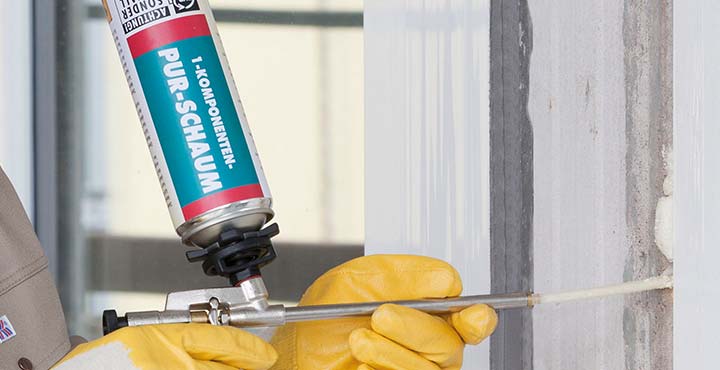
Why is this important?
The yield of a 1-component construction foam is often an important decision-making criterion. The key figure of the joint yield should give you a realistic idea of how high the foam yield of your PU foam can will be if you want to use the foam in joints.
How is this specification different?
This specification differs from other methods in which the foam yield is tested in the laboratory under optimal conditions. For example, if you apply a PU foam freely on a surface rather than in a joint, the yield will be higher.
What else should you consider?
The foam yield is an important aspect to consider when making a purchase. However, you should also note that a PU foam with a higher density can also mean a higher insulating effect.
What unit of measurement do you use to recognise foam density and joint yield?
For comparison purposes, the joint yield must be indicated in metres in length for a standard joint of 20 mm width (a) and 50 mm depth (b). If other joint dimensions have been tested, the width (a) and depth (b) must be given.
The Feica test method TM 1002 is equivalent to EN 17333-1, method 1
Foam yield of a 1-component PU can foam (TM 1003, TM 1007)
Why is the specification of the foam yield interesting?
If you buy a can of PU foam, you want to know how economical the can is. The key figure of the foam density is meant to give you a realistic idea of what foam volume you can expect when you freely apply the can foam.
How is this specification different?
This specification differs from the foam yield in joints described above (TM 1002). A freely foamed foam will always yield a larger volume than one foamed into a joint.
This is how the foam yield is measured:
The entire content of the can is emptied into a box with defined dimensions. The foam volume (yield) is determined by water displacement of the cured foam.
The unit of measurement for foam yield for free foaming is given in litres.
The Feica test method TM 1003 is equivalent to EN 17333-1, method 2 and TM 1007 to EN 17333-1, method 4
Shape retention of a 1-component building foam (TM 1004)
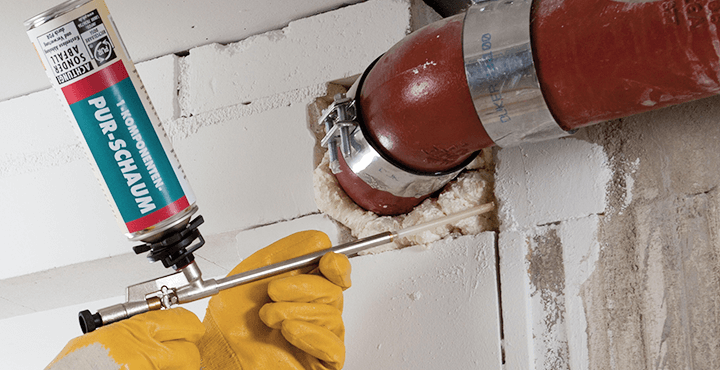
What does shape retention indicate?
Shape retention is also called dimensional stability. This refers to the shrinkage or expansion of cured PU foam under extreme and typical conditions.
Why is this value important?
Normally, 1-component foams tend to shrink within the first few days after curing as gas escapes from the closed cells. The resulting negative pressure in the cells reduces the cell size. This causes the entire foam to shrink. As a rule, this effect is compensated for over several days by the slower ingress of air.
Shrinking foam can affect the sealing of joints by detaching from the surface or deforming the joints. The extent of shrinkage depends not only on the foam formulation but also on environmental conditions such as humidity.
Dimensional stability is always relevant. It is of most importance for door frame foams and of least importance for bonds where the gap is very small.
What unit of measurement is used to indicate the dimensional stability of your foam?
The values are given as a percentage. The closer this is to zero, the better.
The Feica test method TM 1004 is equivalent to EN 17333-2, method 2
Cutting time of a 1-component construction foam (TM 1005)
Why is this important?
The cutting time shows you how quickly you can process your construction foam. It specifies after how many minutes you can cut the freshly applied foam and continue working.
The cutting time should not be confused with the resilience of a foam or the curing time (link), i.e. the time at which the foam has reached its full strength and load-bearing capacity.
When is the foam considered to be free to cut?
PU foam is considered free to cut when no fresh polymer remains on the blade after cutting with a sharp knife, the foam cells are crushed or the cut surface itself is still sticky.
What should you consider in practice?
How quickly you can actually continue working with your construction foam depends not only on the foam itself, but also on other factors such as the air humidity, the temperature or the diameter of the applied foam line.
The tests in the laboratory, the measured values of which are later given in the product data sheet, take place under standardised conditions and refer to a foam line with a diameter of three centimetres.
Above all, the data allow you to compare the quality of a construction foam with that of others. Basically, the shorter the cutting time, the better, as the foam structure benefits from a short curing time.
What unit of measurement is used to indicate the cutting time?
This is indicated in minutes.
The Feica test method TM 1005 is equivalent to EN 17333-3, method 1
Sagging behavior of 1-component PU foam (TM 1006:2013)
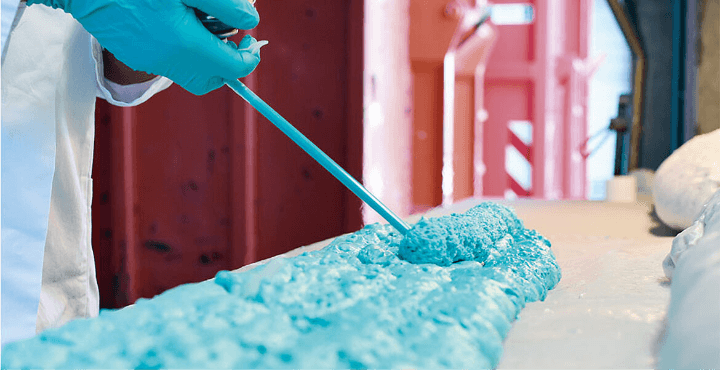
When is this quality criterion important?
The stability of PU foam is particularly important if you want to fill in a vertical joint. The PU foam should fill the joint and solidify in it without the liquid foam slipping away after application.
What does the sagging behaviour indicate?
On the one hand, it determines how much a foam tends to sag. On the other hand, the value serves to determine the maximum joint width at which the foam does not slip downwards when used.
Which unit of measurement indicates the sagging behaviour and what does it mean?
The sagging behaviour is measured in centimetres. This is what the values mean:
- d =< 1 cm: no slipping
- d =< 3 cm: slight slippage – the foam is still in the joint, but has sagged slightly downwards
- d > 3 cm: strong slippage – the foam is not evenly solidified in the joint. It has sagged partly or has flowed out of the joint completely.
The Feica test method TM 1006:2013 is equivalent to EN 17333-3, method 3
Quality criterion for brittleness (TM 1008)
Why is this information important?
Polyurethane foams can become brittle during the curing phase, especially at cold temperatures. Although the foam becomes flexible again at higher temperatures, it can remain permanently brittle in cold environments. Especially in winter, this impairs the suitability of the foam for use.
Which values determine the brittleness?
The degree of brittleness is indicated in grades ranging from creaking to breaking of the surface to pulverisation of the foam. The lower the brittle point, the better the quality of the foam.
Curing pressure (TM 1009)
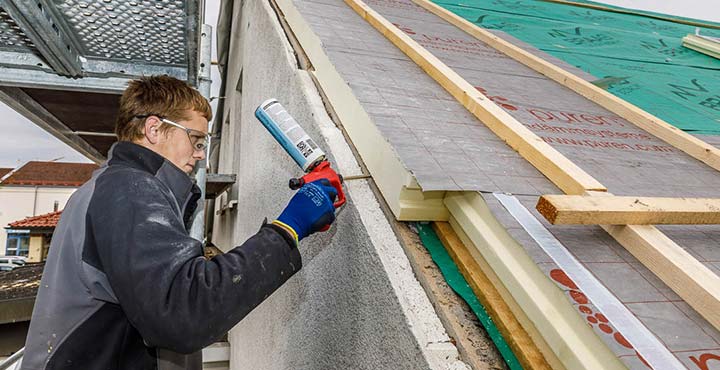
What does this mean?
When construction foam hardens, its volume also increases, which in turn exerts pressure on its surroundings. This is desirable, so that the foam combines well with the building materials surrounding it. If the pressure is too high, however, it can deform the joints. In principle, the pressure can be absorbed by the temporary installation of clamps or spacers. If this is not possible, you should use PU foam with a low curing pressure. This value is closely related to the post-expansion factor (TM 1010).
What value do you use to show the curing pressure?
The curing pressure is given in the customary international unit kPa (kilo-Pascal).
The Feica test method TM 1009 is equivalent to EN 17333-2, method 2
Post-expansion factor of PU foam (TM 1010)
What is a post-expansion factor?
The post-expansion factor describes the expansion of the freshly applied foam during its curing phase. This value is closely linked to the quality criterion for curing.
Why is this important?
Freshly applied construction foam expands even further as it hardens. This effect, which is desirable in itself, can have unwelcome consequences. For example, when a joint has been filled completely with fresh foam and then swells so much that it contaminates its surroundings.
The post-expansion factor is designed to help estimate how much foam you can put into a joint without risking over-expansion. Or in other words: how much space you should leave for the post-expansion of the foam.
When should you avoid using heavily expanding foams?
Whether you choose a more or less expanding foam is largely a matter of personal preference. In general, wherever you need to work very precisely, you should choose a foam that only expands a little. This is especially useful if you do not work with PU foam very often and have little experience with post-expansion. If holes simply need to be filled, a strongly expanding foam is advantageous.
Which units of measurement apply to this quality criterion?
The values are given as a percentage. The higher the percentage, the more the foam expands further in the curing phase.
The Feica test method TM 1010 is equivalent to EN 17333-2, method 3
The quality criterion of compressive strength (TM 1011)
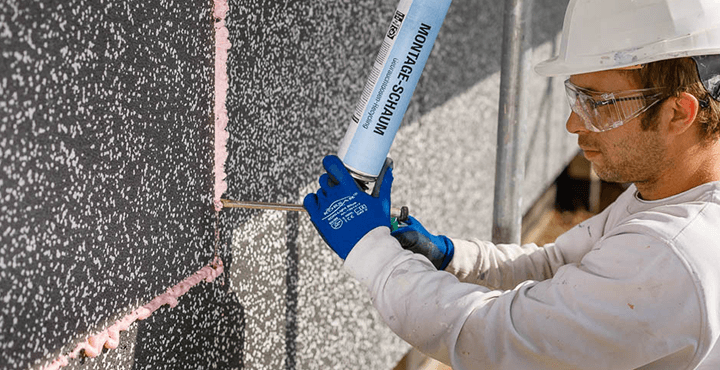
What does this mean?
The compressive strength indicates the foam’s resistance to pressure distributed over the surface. It specifies the compressibility or flexibility of the cured foam.
Why is this important?
One of the main areas of application for construction foams is thermal insulation and sound damping in connection joints. The PU foam in these joints must absorb the movements of the building elements caused by factors such as temperature fluctuations or wind loading. To do this, the insulating material needs to be both strong and flexible. This is the only way it can withstand the repetitive compression-tensile cycles.
You can recognise the compression force by this value
The compression force is expressed in pascals (Pa) or kilopascals (kPa). The higher this value is, the more pressure-resistant and thus harder the PU foam is.
The Feica test method TM 1011 is equivalent to EN 17333-4, method 1
The shear strength of PU can foams (TM 1012)
When is shear strength important?
The shear strength is an important characteristic of the foam that is needed to evaluate its fixing strength, especially for fixing door frames. It is useful for calculating the required fixing surface for a specific door leaf weight or vice versa.
The unit of measurement for shear strength
This value is also given in kilopascals (kPa). The higher the value, the more stable the selected foam is against parallel tension.
The Feica test method TM 1012 is equivalent to EN 17333-4, method 3
Flexibility and movement absorption (TM 1013)
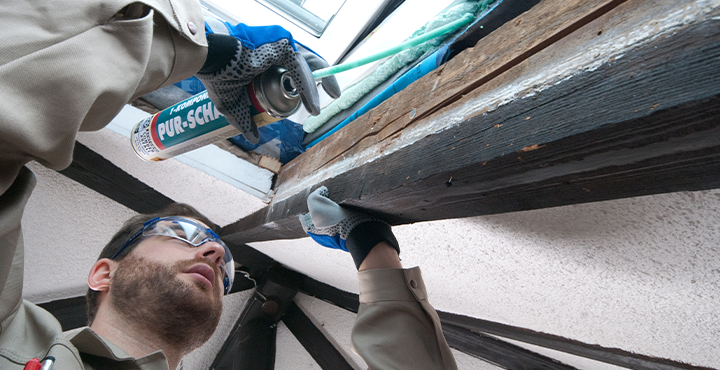
What does flexibility indicate?
The flexibility of the cured PU foam gives an indication of the extent to which the selected foam can withstand component movements without tearing.
When is this important?
Like compressive strength (TM 1011), a foam’s flexibility is also an important quality feature when it comes to compensating for joint movements caused by temperature fluctuations, wind loading, etc. This is particularly important for window joints. The larger the window, the more important the flexibility of the insulation foam used.
How can you recognise flexible foams?
The flexibility of PU foams is specified as a percentage. The higher the percentage, the more flexible the foam is.
The Feica test method TM 1013 is equivalent to EN 17333-4, method 4
The tack-free time of construction foam (TM 1014)
What is meant by tack-free time?
‘Tack-free time’ specifies the time from which the surface of the applied foam no longer sticks. The tack-free time depends on the temperature and humidity conditions. It is usually extended by a lower temperature and/or low humidity.
What unit is used for this criterion?
The result is expressed in minutes.
What should you not confuse the indication of tack-free time with?
You should not confuse the tack-free time with the cutting time (TM 1005). The foam is not yet fully cured when the tack-free time is reached. If you cut it now, the foam cells will be destroyed and the foam will collapse.
The Feica test method TM 1014 is equivalent to EN 17333-3, method 2
Expansion time of frame foam or how long it takes until you can remove the spacers when installing a door (TM 1016)
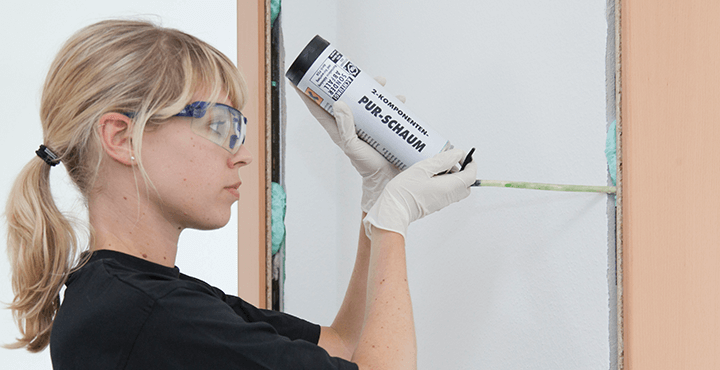
When is this quality criterion important for you?
The specification of the expansion time of self-curing PU foam is particularly important when installing interior doors. The usual expansion of the foam placed in the gap between the frame and the adjacent wall would deform the door frame during curing.
To avoid this deformation, the frame is stabilised with spacers, called "spreaders". They should only be removed when the foam is no longer expanding.
The expansion time is the minimum time you have to wait before you can remove the spreaders.
What should you not confuse expansion time with?
Even if the foam does not expand any further, this does not mean that it is already fully cured and fully resilient.
What unit of measurement is used to measure the expansion time of construction foam?
This is indicated in minutes.
If you are interested in the exact test methods, you can find them on the FEICA website under this link.
Foam density (TM 1019)
What is this information used for?
In general, foam density is a characteristic that is applied for product identification. It is also an indication of the foam yield and firmness of the product. The lower the density, the higher the foam volume that can be achieved and the lower the strength.
When assessing the filling of the joints of a construction foam can, the density and the expansion in linear metres according to TM 1002 are the more meaningful data.
The Feica test method TM 1019 is equivalent to EN 17333-1, method 3
The long-term thermal conductivity of construction foam (TM 1020)
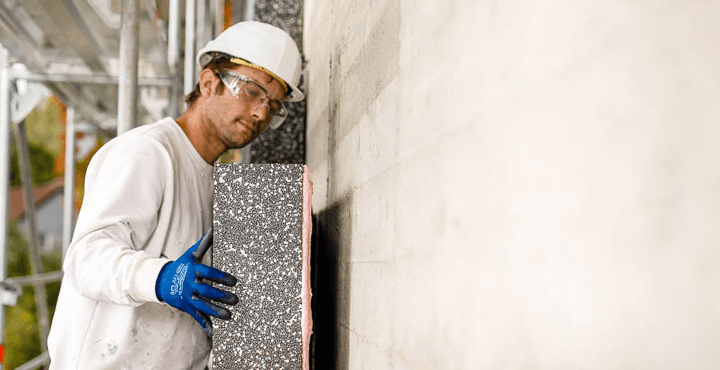
What does this information tell you?
One of the most important characteristics of polyurethane foam is its very good thermal insulation. This makes it perfect for sealing window joints and external doors. The lower its thermal conductivity, the better it helps to save energy.
What unit of measurement do you use to specify the value?
Thermal conductivity is specified in W/mK (watts per metre Kelvin). This value is also known as the ‘k-value’. The lower this value is, the better the selected construction foam will insulate.
The Feica test method TM 1020 is equivalent to EN 17333-5

![[Translate to Englisch:] PU Schaum, Sicherheit [Translate to Englisch:] PU Schaum, Sicherheit](/fileadmin/PU-Schaum-Center/PU-Schaum_in_der_Praxis/img_sicher_arbeiten_mit_PU-Schaum.jpg)
![[Translate to Englisch:] 1 K Schaum [Translate to Englisch:] 1 K Schaum](/fileadmin/PU-Schaum-Center/PU-Schaumarten/img_PU-Schaumarten_1-K-PU-Schaum.png)
![[Translate to Englisch:] 2 K Schaum [Translate to Englisch:] 2 K Schaum](/fileadmin/PU-Schaum-Center/PU-Schaumarten/img_PU-Schaumarten_2-K-PU-Schaum.png)

